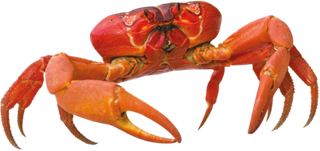SearchingfortheSea
AredtideflowsfromtheforesttotheseaeveryfallonChristmasIslandinthePacificOcean.That’swhenmillionsofChristmasIslandredcrabsmigrate.Theyskittertotheseatoreleasetheireggsintotheocean.Howdotheyknowwhattodo?
Theirtrekistriggeredbytherainfall.Duringtheisland’swetseason,beginninginOctober,thecrabsabandontheirrain forestburrows.Thetimingoftheirmigrationisalsolinkedtothephasesofthe moon.
FastFact:
Morethan120millionredcrabstransformChristmasIslandintoavastmovingredcarpetastheymoveen masse.

Malestravelfirst,ingreatnumbers.Theyareundeterredbyobstacles.Theyfrequentlycrossislandroads,essentiallyshuttingdowntrafficforany“migrating”humans.
Thetripusuallytakesaboutaweek.Onceoceanside,themalesdigdeepburrowsandwaitforthefemalestoarrive.Matingtakesplaceinorneartheburrows.Themalesreturntotheforest.Preciselyattheturnofthehightideduringthelastquarterofthemoon,thefemalesreleasetheireggsintotheocean.Thenthey,too,returntotheirhomes—drivenbythesameforcesthatbroughtthemtothesea.Theyounggrowupintheseaandcome tolandas adults.
Millionsofredcrabsmakeamaddashtotheseaaspartoftheirmigration.